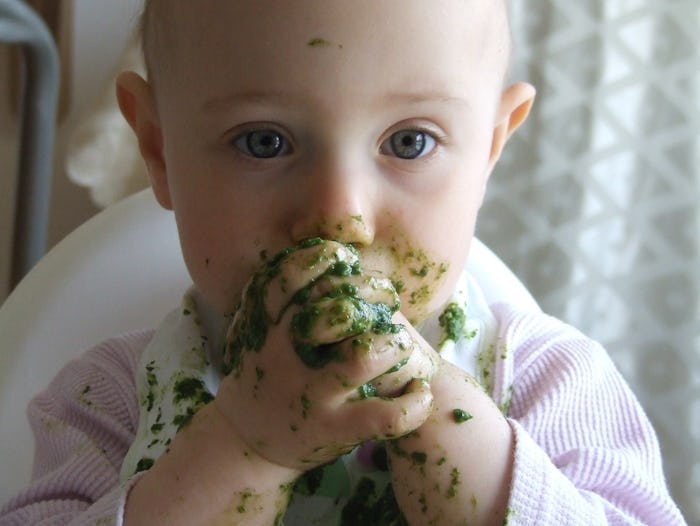You've been a mom for a few months, and you've finally gotten the hang of the whole feeding thing. You've even given yourself extra credit for learning to anticipate your baby's hunger. But as you already know, once you get the hang of something, it's time to start thinking about something else. This time, it's whether or not to add solid foods to the mix. If you're wondering if the formula or breast milk you're giving your baby is enough, you might want to look out for some of the ways your baby is trying to tell you they're ready for solids.
According to the American Academy of Pediatrics, breastfeeding is recommended as baby's sole source of nutrition for the first six months of life. Contrary to some of the unsolicited advice you may be receiving, when your baby is ready for something a little more than the bottle or the boob, you'll know it. Being able to sit upright, grab things with his thumb and index finger, and appearing hungry after his normal bottle or breastfeeding sessions are just a few signs that your baby is interested in solids. You may even catch him checking out some of the foods on your plate.
When you're ready to give your baby his first taste of solids, proceed with caution. As the American Academy of Pediatrics mentioned, parents with food allergies should steer clear of common allergy-inducing foods such as nuts and dairy products. Begin by offering meat or iron-fortified infant cereal mixed with breast milk or water. Once baby gets accustomed to the new additions to her diet, you can slowly introduce applesauce, strained fruits and veggies. Try to wait a few days before adding new menu items to ensure there are no bad reactions. And as always, you should discuss any concerns with your pediatrician.
When it comes to starting solids, let your baby lead the way. In a few months, when you're scrubbing strained peas off of your walls and floors, you'll be glad you did.
1They Have A Big Appetite
If it seems like his usual bottle feedings or nursing sessions just aren't enough, your baby may be looking for a little something more. As Baby Center pointed out, it could be time for solids if baby is still hungry after receiving 8 to 10 feedings of breast milk or formula.
2They Can Sit Upright
Before you break out the solids, you should ensure your baby is ready to sit up and enjoy all of the delicious new flavors you're about to introduce into her diet. Baby should be comfortable sitting upright in a high chair for feedings, as The Stir pointed out.
3They Eye Your Plate
Do you catch your baby drooling over your pasta or trying to grab a handful of your popcorn? As Baby Center mentioned, a curiosity for the food you are eating could be a signal that your baby is ready for solids.
4They Move Their Tongue
A big part of being ready for solid food is mastering the mechanics of taking food into the mouth and swallowing it without a problem. As Gerber mentioned on its website, if baby moves his tongue back and forth when you put a spoon to his mouth, he's ready to swallow solid food.
5They Grab Things
Mastering the pincer grasp is huge milestone for your baby when it comes to solid food readiness. When baby begins to pick things up with her thumb and first finger, it is a sign that she's ready to start snacking on Cheerios, as The Stir mentioned.
6They Are Trying To Chew
Even before you give baby his first taste of applesauce, he's already practicing to take a bite of his first burger. According to La Leche League International, when your baby begins imitating the chewing motion, he is showing signs of solid food readiness.
7They Have Head Control
Your baby's developing gross motor skills are a good indicator that he'sready for more than the bottle. Baby should be able to hold his head up steady before you begin to introduce solid foods, as Gerber recommended.
